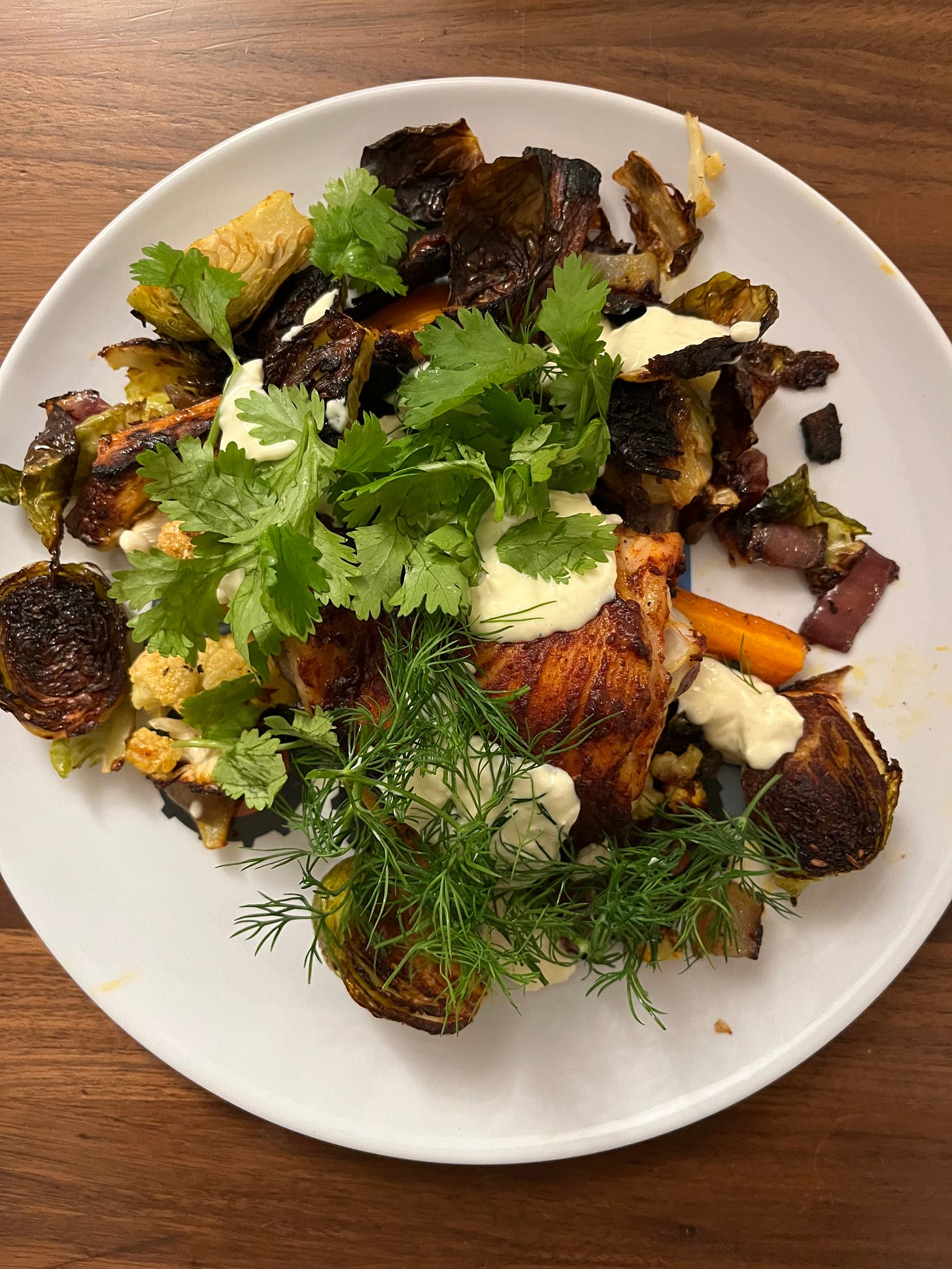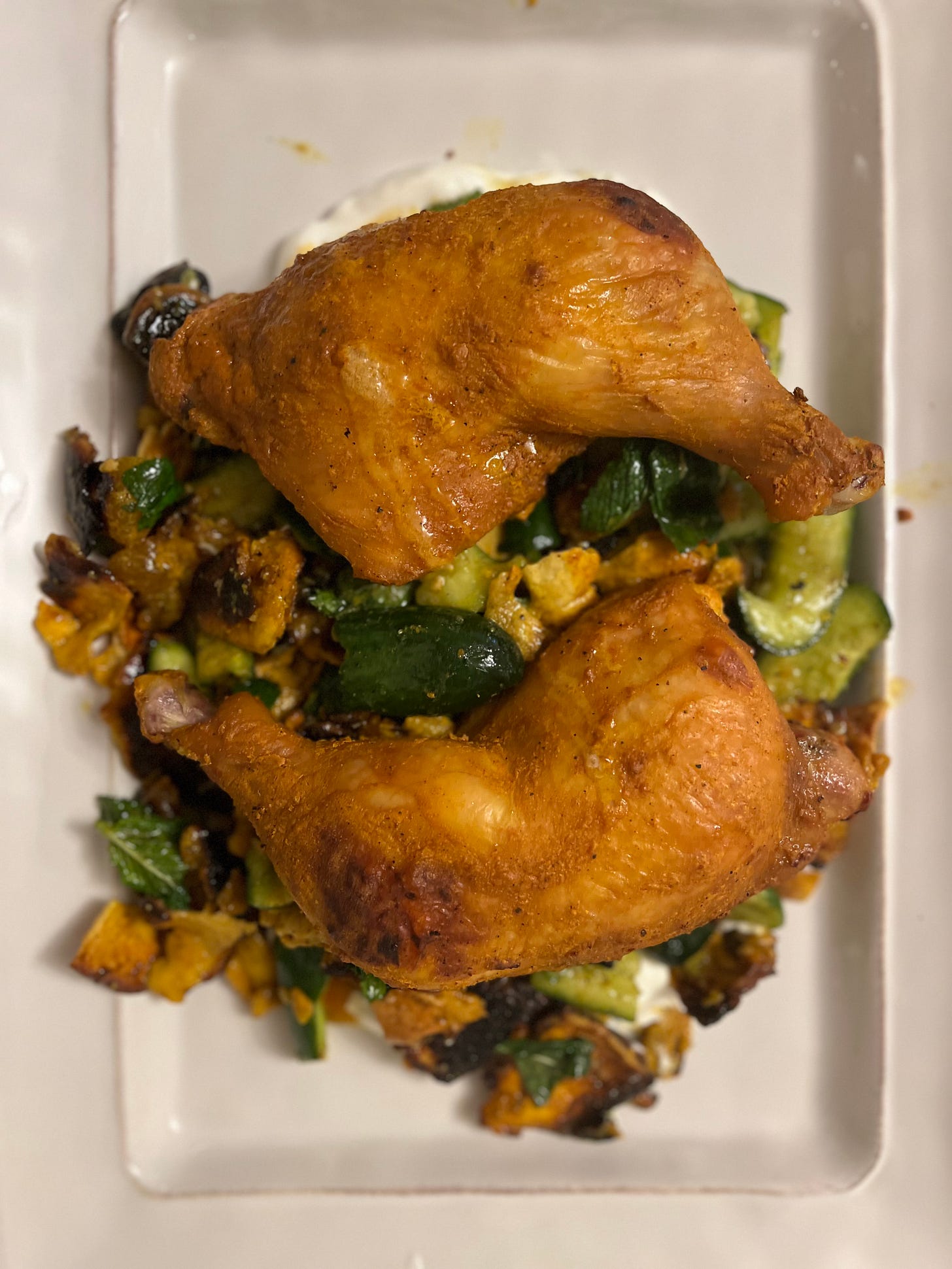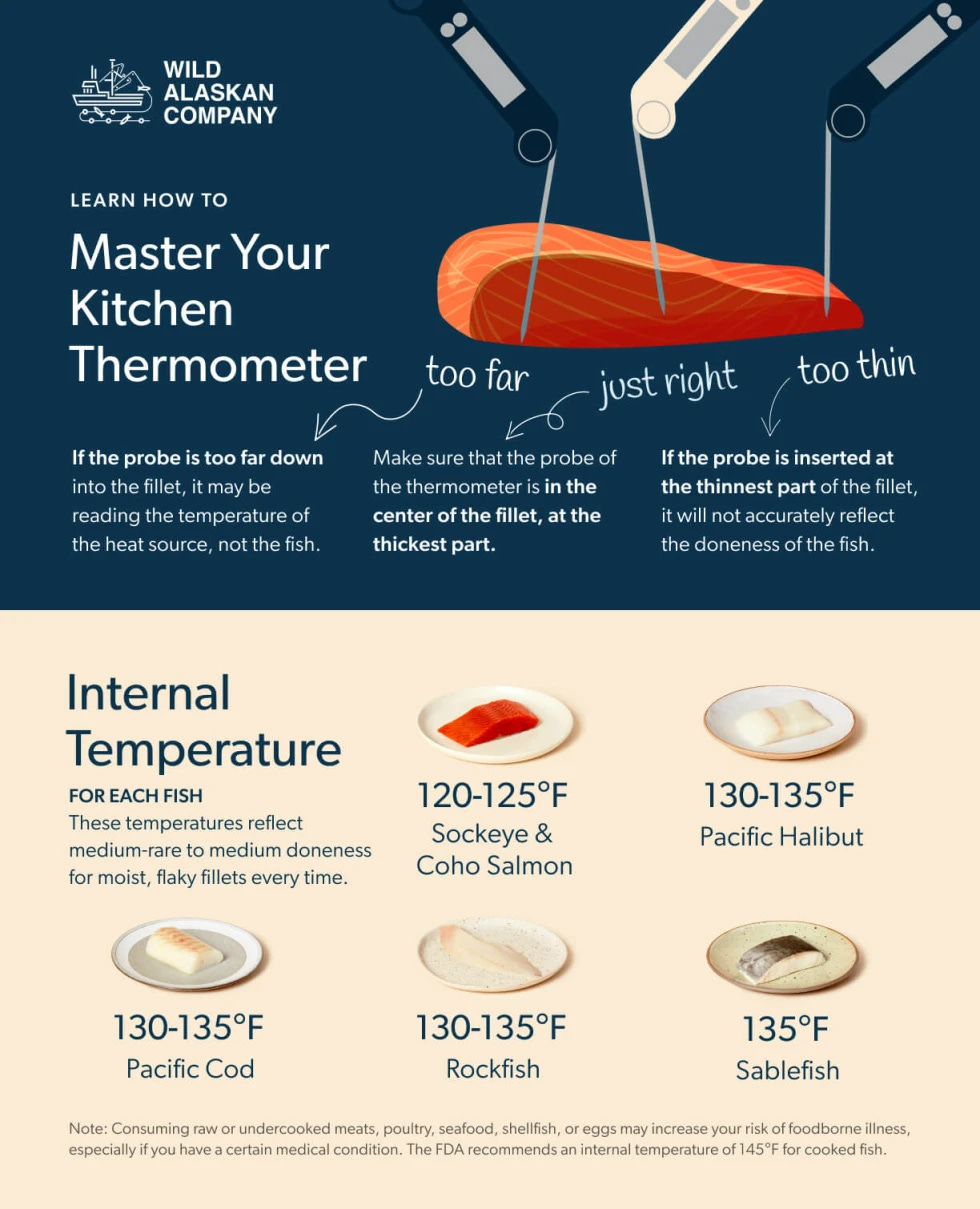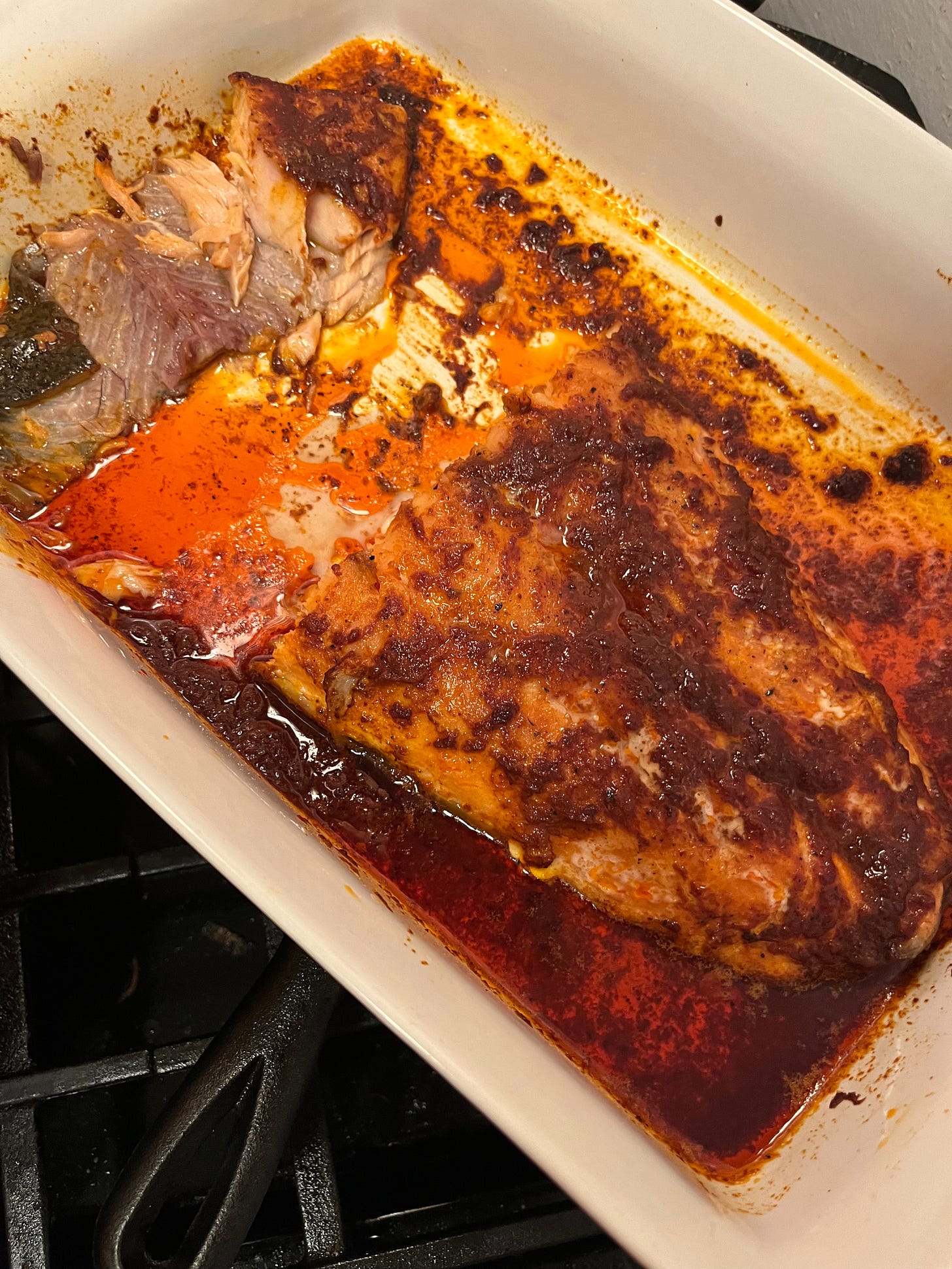Welcome back! Two weeks ago I was struggling to string two thoughts together, but this week I am ready to rock and roll. I also hope everyone had a happy Easter!
This is the week of recipe suggestions. I link to almost a bajillion recipes in today’s newsletter, or 10 to be exact. If you need to make life interesting in the kitchen again, don't miss this one.
An Update
We all know how I am feeling about the new Defined Dish cookbook, which I am currently working my way through for my next full-length cookbook review. If you don’t know, well, then this is awkward because I am really not liking it…for the most part.
Of the eleven dishes I have made thus far, there are only two that I will make again and can, in good conscience, recommend. Of the two only one is available online; it is actually a recipe that has been on the Defined Dish website for a while, and it’s good.
Coincidentally it was also the dish that I opted to make for my theoretical Dinner with Vincent Van Gogh: Sheet Pan Salmon Niçoise Salad. So, I do have to give Alex Snodgrass credit. It’s a really tasty salad; it’s veggie-forward; and it utilizes one sheet pan, which can be a win if done correctly (more on this below).
It’s also perfect for spring/summer. I was born and raised in Arizona and even though I haven’t lived in Arizona for 14 years, my seasonal clock still tells me that April should be a hot month (as I write this it’s 41 degrees and rainy in NYC). So, perhaps some of you are ready for a few recipes to go with your 100-degree weather.
I was recently texting with my friend Mary and discussing all things Defined Dish. Mary actually introduced me to Defined Dish….and Lidey Heuck…and Molly Baz. You could call her the secret genius behind Can’t Help But Cook. Anyway, we were chatting about the fact that I am so surprised that I don’t like the newest cookbook given how much I have loved her recipes in the past. As I was texting her I had the thought that maybe it’s a problem that is specific to this cookbook rather than her recipes more broadly.
Since her last cookbook, Comfortable Kitchen, was published in 2021, Alex has launched a brand of healthy-ish sauces and salad dressings. So, I think it’s possible that her focus has veered more toward that section of her brand. As an experiment, I decided to make a dish from her website. It’s a dish I have made a few times in the past and one that I remember loving.
I made her Sheet Pan Harissa Chicken + Veggies with Garlic Aioli, and I loved it! We all did. My husband said it tasted like “Molly Baz”, which is the highest form of compliment in our household. My son’s exact words were “yummy delicious.”
I do want to give Alex credit here because she absolutely deserves it. The subtle hint of curry powder is brilliant. The veggie combination is excellent. I could go on, but you get it; it was good!
That being said, if you are going to make this, I have a few suggestions to amplify the flavor simply by editing some of the directions.
Salt: I recommend salting the chicken and vegetables first before you add the olive oil. I also recommend salting them separately. If you have time, salt the chicken thighs an hour before you begin to cook and let them sit at room temperature while the salt works its magic. A reminder that you want to use 1 tsp Diamond Crystal kosher salt per 1 lb of meat. On average, 2 chicken thighs = 1 lb.
Use this harissa instead. I have used both Mina harissa and New York Shuk, and I wholeheartedly prefer the latter.
Use two sheet pans: A common problem that I observe in sheet pan meals is overcrowding. When you cram a bunch of vegetables and meat onto a sheet pan, such that they are all touching and on top of each other, they steam instead of roast. If you want charred, well-roasted brussels sprouts (as shown below) you need to give them their space.
What I recommend here is placing both oven racks in the bottom two slots in your oven. Spread the vegetables and chicken out between two sheet pans. Halfway through cooking — at approximately the 20-minute mark — remove the sheet pans from the oven, toss the vegetables, and switch the position of the two sheet pans in the oven.
So, maybe Defined Dish’s sheet pan recipes are where it’s at for me? All three recipes I am discussing, including the Sheet Pan Sausage And Sweet Piquante Peppers from Dinner Tonight, involve a sheet pan.
Speaking of Sheet Pans
If you’ve become as big a Molly Baz fan as me and you subscribe to The Club, I made her Turmeric Chicken with Schmaltzy Pita and Cukes, which released two weeks ago, and loved it. Molly said in the blurb to introduce the recipe that she’s not a fan of the phrase “sheet pan dinner…[because] it suggests you are taking a knee on proper technique and prioritizing speed over deliciousness.” Molly is about to become a first time mom, however, so she’s learning the appeal of an all-in-one sheet pan dinner. Or, at least that’s my read on the situation.
I consider it to be a weeknight-friendly meal. Just thought you should know!
A New Molly in Town (Again)
I have decided to begin working on a second cookbook review in tandem with Defined Dish’s Dinner Tonight.
My reasons are threefold.
I need to feel inspired. If I am not inspired and excited about cooking, I do not recognize myself in the mirror. I am not regularly excited by Defined Dish’s cookbook, ergo I need some fresh inspo.
I need to compare. Every time I make an observation about Dinner Tonight, I realize that that same observation doesn’t dampen my love of other cookbooks. I’m hoping that by working on two, side by side, I can hone my personal critiques of – and praise for – Dinner Tonight.
I need a little less spice. Now, it pains me to write this, but it’s true. Defined Dish’s recipes have a lot of spice built in. In many of her recipes, it’s nearly impossible to take out the spice without sacrificing most of the flavor. Try as I might, my kids just aren’t ready for sriracha-laden dishes.
Enter: Molly Yeh’s Home is Where the Eggs Are. My in-laws gave me this cookbook for Christmas, and honestly, it was one of my favorite gifts. Let that be a lesson to you all: you don’t have to reinvent the wheel to get someone a really personal, thoughtful gift.
I’ve made a few recipes from it so far, and most of them I have really enjoyed! When I am considering reviewing a cookbook, my MO is to grab a pile of sticky notes and flip through each recipe. If the recipe excites me – i.e. looks yummy and doable – I plop a sticky note down. Well, as I was combing through Home is Where the Eggs Are last week, sticky notes were flying every which way. Then, immediately after making it through the final recipe, I was so excited to feel excited again that I jotted down my reactions to the cookbook:
If you can’t read the sticky note, my shorthand comments are as follows:
Love seasonality
Mom of young kids
Cooking science (i.e. she pays attention to things like salt, fat, acid, and heat)
NYC
Fun
Low key
Combo of cuisines
In the weeks to come, I will dive into all of these things. Molly Yeh has a really cool story that involves living in NYC while attending Juilliard and now involves living and working on her husband’s family’s beet farm in Minnesota with her two young kids.
In the meantime, I will share the recipe that I make the most often: Broccolini Sausage Lemon Deep Dish Pizza. As the article notes, this is a recipe that Molly came up with after having her first child, and if you have kids (or any version of a busy-ass life), you will see why I make it frequently.
Technique of the Moment: Fish
I honestly could kick myself for starting this series on fish with poaching instead of slow-roasting. Again, nothing wrong with poaching. I really enjoy it! But, if you were to give me one chance to prove to you that fish can be done exceptionally well, I would direct you to slow-roasted fish.
I wasn’t able to get into too many specifics last time, so let me rectify that now by providing an overview of the important factors in the perfect slow-roasted fish.
The Perfect Fish
To achieve mouth-wateringly good fish, you need to focus on two things: salt and heat.
PLEASE NOTE: No amount of acid (i.e. lemon) can save a fish that is under-salted and/or overcooked.
Here is the link I shared last time. It’s Molly Baz describing why slow-roasting fish is the best way to cook it.
Salt. You need to salt your fish well and, ideally, let it sit on the counter for 15 minutes after salting and before putting it in the oven. I learned this from Samin Nosrat’s book, Salt, Fat, Acid, Heat, and it has forever changed my relationship with both salt and fish. DO IT. TRUST ME.
And, yes, you absolutely need to use more salt than you are using, but please, please make sure it’s Diamond Crystal kosher salt. I would bet good money that you aren’t using enough salt on your fish. When I salt fish I come in at just barely under 1 tsp per 1 lb. I think ¾ tsp per 1lb is a good place to start, but probably a smidge more than that. Notice if you think it needs more and adjust accordingly next time. Because, yes, you will want to make some type of slow-roasted fish again.
Heat. A few weeks ago I made yet another Defined Dish Sheet Pan recipe from Dinner Tonight. It was a slow-roasted halibut recipe inspired by all things Hawaiian cuisine. Certain filets were delightful and others were borderline inedible. Want to know why? Some were cooked perfectly to medium and others were overcooked at well-done. The difference between the two was so unbelievably startling my husband looked at me and said “Please put this in your Substack. I think most people are overcooking their fish.”
There are two ways to test for doneness. If you want to be really precise (or are anxious about eating undercooked fish), use a meat thermometer. I would really encourage you to try fish medium rather than well done. For whatever reason, people are skeptical of eating fish when it’s cooked to medium. If this is because you associate medium with the reddish inside of a hamburger, it’s not the same with fish. When fish is cooked to medium, the flesh is also opaque. You aren’t going to be eating fish that looks like raw sushi in the middle.
Again, the difference between the two is so drastic, you won’t believe they are the same fish. Medium temperature is different for every fish. Salmon is 120-125 degrees Fahrenheit, while something like Halibut or Cod is 130-135. Here is a helpful graphic from an article describing the optimal internal temperature of various fish.
You can also test doneness by placing a fork in the thickest part of the filet and turning the fork. If the filet is opaque and flakes when you twist the fork, you are good to go.
I will also share Alison Roman’s advice for testing doneness:
“Your best way to tell the doneness of the fish is by change of color and texture- rare/raw fish will be deeper in color and soft/squishy to the touch, well done fish will be light/paler pink and firm/bouncy to the touch).”
Filet Size
Slow-roasted fish recipes generally call for one, large single piece of fish. It’s typically a 1.5 - 2lb filet. This is because they want you to avoid the situation I encountered with Defined Dish’s halibut recipe, wherein the filets cook at different rates.
I agree this is ideal, but I have made slow-roasted fish with two medium filets and a number of single-size filets when that’s all I can find. You’ll notice in one of the photos from Vol. 12 two weeks ago that when I made Ali Slagle’s Salmon to Get Your Groove Back, I used two large filets rather than one really big filet. That’s all my fishmonger had.
If you are using more than one filet, do your best to keep the sizes of the individual filets similar. When I am making a dish with more than one filet I begin to check the temperature 5-10 minutes earlier.
The beauty of slow-roasting fish is that you can check the temperature a few times without having to worry that too much heat is escaping from your oven. Like Molly Baz says, it’s forgiving. If you get distracted for a few minutes, it might rise 2-3 degrees higher than you want but it won’t go from medium to well done.
Molly Baz’s Slow-Roasted Salmon
If you belong to The Club, I implore you to make Molly’s Slow Roasted Salmon with Citrus, Soy Butter and Basil. It was the second Molly Baz recipe I ever made, and it was after making this recipe back in early 2023 that I instantly became Molly’s biggest fan.
If you don’t want to join the club, no worries. Here is another Molly Baz slow-roasted salmon that uses harissa.
Two Alison Roman Slow-Roasted Fish Recipes
I’m sharing two recipes that are fairly similar to each other, but the salads that accompany them are different enough to treat them as two separate recipes: A Really Nice Fish with Cucumber and Crunchy Garlic Salad and Slow Salmon with Citrus and Herb Salad. Both recipes give a few suggestions for various fish you can use. I used cod when I made the former and salmon when I made the latter. Even though salmon is my favorite fish, I preferred the first recipe, mostly because I really liked the Cucumber and Crunchy Garlic Salad (and the cod was fantastic).
Alison Roman does two things exceptionally well: fish and “do ahead” suggestions. At the bottom of most recipes, Alison will let you know if you can prep anything ahead of time. I find these suggestions extremely helpful and stress-relieving.
A note on Salmon Types
There are different types of salmon swimming around out there, and they cook very differently. I love wild sockeye salmon, which is the darker, thinner type that hails from the great state of Alaska. However, in my experience, sockeye salmon is harder to slow roast because it’s thinner and tapered. I’m not saying you can’t do it, but in my experience, fatty, center-cut Norwegian salmon is the best for slow-roasting.
I want to be cognizant of the fact that my tastes and your tastes might not align. My goal isn't to get you to make every Molly Baz recipe on planet Earth so much as it is to get you to cook the food you're making well. So, I'm going to share a Defined Dish slow-roast salmon recipe that I thought was decent enough. It was far from my favorite, but if it looks good to you, make it! If you like it then there's a good chance you might like more of her recipes.
One non-food-related thought (-ish)
Ooof. Man. I have a lot on my mind right now. Most of it is personal and heavy. A painful awareness of the various seasons of life, as well as life’s brevity.
In the midst of all of this, I am even more grateful for my husband and my marriage, and I feel myself leaning on him a lot right now while I process other challenges and uncertainties. That being said, we haven't had a lot of one-on-one time together. I can count on three fingers the number of dates we went on in 2023. We need some time away. So, we are going on a date tomorrow night, and I am really excited.
My husband and I were married for 5 years before we had kids. The challenges of that are self-evident. You don’t go from countless nights out in East Village and midnight shows at The Comedy Cellar to teething babies and 5am wake-up calls without some painful adjustments. But, the benefits are there as well. We experienced 5 years of growing in honest, good old fashioned friendship. As such, we are sensitive to what it feels like when the friendship component of marriage starts to lag behind all things mom & dad.
Hence tomorrow night's date! And we're not going around the corner to some spot in our neighborhood either. Like the New Yorkers that we are, we are going to get on the subway, go to a completely different part of town (read: younger part of town), pay some talented chefs to prepare us delicious sushi, order some sake, talk about all the things friends talk about, and maybe even head to a swanky cocktail bar for a nightcap.
One of my favorite podcast episodes I have recently listened to talked about living in the tension between joy and sorrow. I very much feel that right now. Sorrow for many reasons but also joy because, as we all know, I believe time spent with people you love over a meal is pretty special and joyful.
See you in the kitchen!
Xo,
Rach











I am so exited to try slow roasting fish! This may be the solution to all my fears surrounding cooking it.
Rachel, your dishes looks absolutely yummy.